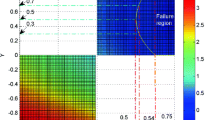Abstract
The concepts of system load and capacity are pivotal in risk analysis. The complexity in risk analysis increases when the input parameters are either stochastic (aleatory uncertainty) and/or missing (epistemic uncertainty). The aleatory and epistemic uncertainties related to input parameters are handled through simulation-based parametric and non-parametric probabilistic techniques. The complexities increase further when the empirical relationships are not strong enough to derive physical-based models. In this paper, ordered weighted averaging (OWA) operators are proposed to estimate the system load. The risk of failure is estimated by assuming normally distributed reliability index. The proposed methodology for risk analysis is illustrated using an example of nine-input parameters. Sensitivity analyses identified that the risk of failure is dominated by the attitude of a decision-maker to generate OWA weights, missing input parameters and system capacity.












Similar content being viewed by others
Notes
In the subsequent sections, the system capacity is assumed a priori known information, either through regulatory guidelines or expert provided data. However, the proposed methods to compute system load is equally applicable
Risk of failure is synonym to probability of failure
Abbreviations
- δ:
-
degree of a polynomial function
- α:
-
degree of orness
- Q(r):
-
linguistic quantifier as a fuzzy subset to generate OWA weights
- Q * (r):
-
linguistic quantifiers “for all” to generate OWA weights
- Q * (r):
-
linguistic quantifiers “there exists” to generate OWA weights
- max:
-
maximum (parameter for uniform distribution)
- μ:
-
mean (normal distribution)
- μ Z :
-
mean of the performance function
- μC :
-
mean of the system capacity
- μL :
-
mean of the system load
- s :
-
measure of scatter (lognormal distribution)
- X o :
-
median (lognormal distribution)
- min:
-
minimum (parameter for uniform distribution)
- Φ:
-
cumulative probability function for a standard normal distribution
- w = (w 1, w 2,...,w n )T :
-
OWA weight vectors
- w j :
-
OWA weights
- Z :
-
performance function
- P f :
-
probability of system failure
- k * :
-
realizations or iterations in bootstrapping
- k :
-
realizations or iterations in MCS
- β:
-
reliability index
- θ:
-
scale parameter (Weibull distribution)
- m w :
-
shape parameter (Weibull distribution)
- σ:
-
standard deviation (normal distribution)
- σ Z :
-
standard deviation of the performance function
- σC :
-
standard deviation of the system capacity
- σL :
-
standard deviation of the system load
- C :
-
system capacity
- L :
-
system load
- b j :
-
the jth largest element in the vector (X1, X2,..., X n )
- \({x^{{k*}}_{1}, x^{{k*}}_{2}, \ldots,x^{{k*}}_{n}}\) :
-
vector of values for input parameters generated randomly for bootstrapping
- \({x^{k}_{1}, x^{k}_{2}, \ldots,x^{k}_{n}}\) :
-
vector of values for input parameters generated randomly for MCS
- F(X i ):
-
cumulative distribution function
- m :
-
number of historical data points
- MCS:
-
Monte Carlo simulation
- n :
-
number of input parameters
- N :
-
number of realizations in MCS
- N * :
-
number of realizations in bootstrapping
- OWA:
-
ordered weighted averaging
- p :
-
probability of event
- P1 and P2 :
-
parameters of the probability distributions
- PDF:
-
probability density function
- X 1, X 2,...,X n :
-
input parameters
References
Ayyub BM, Chao R-J (1997) Uncertainty types and modeling methods. In: Ayyub BM (ed) Uncertainty modeling and analysis in civil engineering. CRC Press, Boston, pp 1–28
Cornell CA, Jalayer F, Hamburger RO, Foutch DA (2002) Probabilistic basis for 2000 sac federal emergency management agency steel moment frame guidelines. ASCE J Struct Eng 128:526–533
Cullen AC, Frey HC (1999) Probabilistic techniques in exposure assessment: a handbook-for dealing with variability and uncertainty in models and inputs. Plenum Press, New York, pp 352
Effron B, Tibshirani R (1986) Bootstrap methods for standard errors, confidence intervals, and other measures of statistical accuracy. Stat Sci 1:54–77
Effron B, Tibshirani R (1993) An introduction to the bootstrap. Chapman and Hall, Inc., New York
Klir GJ (1985) Architecture of systems problem solving. Plenum Press, New York
Klir GJ, Yuan B (1995). Fuzzy sets and fuzzy logic: theory and applications. Prentice Hall International, Upper Saddle River
Knight F (1921) Risk, uncertainty, and profit. Boston, Haughton Mifflin
Lewis EE (1987) Introduction to reliability engineering. Wiley, New York
Lowrance WW (1976) Of acceptable risk. William Kaufmann, Los Altos
Melchers RE (1987) Structural reliability: analysis and prediction. Ellis Horwood, Chichester
Ott WR (1978) Environmental indices: theory and practice. Ann Arbor Science Publishers, Michigan
Paté-Cornell ME (1996) Uncertainties in risk analysis: six levels of treatment. Reliability Eng Syst Saf 54:95–111
Ricci PF, Sagen LA, Whipple CG (1981) Technological risk assessment series e: applied series no. 81
Rowe N (1977) Risk: an anatomy of risk. Wiley, New York
Sadiq R, Kleiner Y, Rajani B (2006) Estimating risk of contaminant intrusion in distribution networks using Dempster–Shafer theory of evidence. Civil Eng Environ Syst 23(3):129–141
Smets Ph (2000) Data fusion in the transferable belief model. In: Proceedings of 3rd international conference on information fusion, fusion 2000, Paris, pp PS21–PS33
Yager RR (1988) On ordered weighted averaging aggregation in multicriteria decision making. IEEE Trans Syst Man Cybern 18:183–190
Yager RR (1996) Quantifier guided aggregation using OWA operators. Int J Intell Syst 11:49–73
Yager RR (2004) Uncertainty modeling and decision support. Reliability Eng Syst Saf 85:341–354
Yager RR, Filev DP (1994) Parameterized “andlike” and “orlike” OWA operators. Int J Gen Syst 22:297–316
Yager RR, Filev DP (1999) Induced ordered weighted averaging operators. IEEE Trans Syst Man Cybern 29:141–150
Author information
Authors and Affiliations
Corresponding authors
Rights and permissions
About this article
Cite this article
Tesfamariam, S., Sadiq, R. Probabilistic risk analysis using ordered weighted averaging (OWA) operators. Stoch Environ Res Risk Assess 22, 1–15 (2008). https://doi.org/10.1007/s00477-006-0090-1
Published:
Issue Date:
DOI: https://doi.org/10.1007/s00477-006-0090-1




